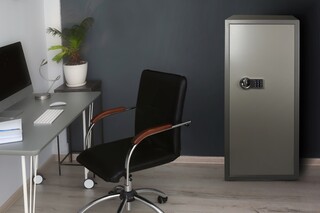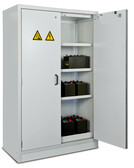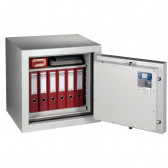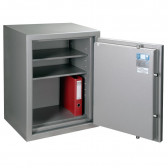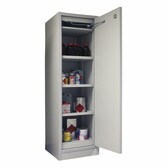Do you manage a large company, run a business or other smaller office activities? That is, you or your employees deal with many documents on a daily basis, which are in circulation but also require specific protection against unauthorised access or theft.
Where do you store important documents in your study or office? We know from experience that they are often stored in cupboards or desks. We know that this is poor security; values can easily fall into the wrong hands. Fortunately, we have an alternative for you. Cabinet safes are the perfect solution – a tool for protection against theft but also an element of stylish interior design.
In this article, we'll discuss what cabinet safes are, their functions and advantages, and give you tips on how to choose the right model to suit your needs.
What are cabinet safes?
Cabinet safes are specialised appliances designed for securing precious items, important documents and data carriers (and sometimes even valuables) in offices and studies. Their construction provides protection primarily against unauthorised access and burglary, and often also against fire. Depending on the model, office safes come in different sizes, have different locks and specific certifications (burglary and/or fire resistance).
Check also: What should a safe for the office have?
Functions of cabinet safes
• Protection against theft: this is the basic and undeniable function of safes. The purpose of safes is to protect the items deposited inside from unauthorised access and potential theft. The structure and security features used make certified safes resistant to burglary attempts. The rule of thumb is simple – the higher the security class of the safe, the more time is required to break through the security.
• Protection against fire: if we are talking about studies or offices – the thought immediately springs to mind that (paper) documents take up the most space there. Paper documents (as well as those stored on data carriers) require special protection, hence the category of safes with flame resistance certificates for paper (P) or data carriers (DIS). Many safe models provide protection against extreme conditions such as fire or flooding. Thanks to the use of special thermal insulation in the body and seals in the door frame, the safes protect the contents from the effects of temperature, but also from water and fire extinguishing agents. At this point, it is worth stating that safes with fireproof certification are common products and available from Hartmann Tresore. In contrast, there are no water-resistant certified safes in our range or on the market.
• Document organisation: Cabinet safes often include shelves, special compartments and additional internal safes for convenient storage of documents, cash, jewellery or other important items. This is an ideal solution for people who value convenience and want to keep their precious belongings organised and easily accessible.
How to choose a cabinet safe?
Choosing the right cabinet safe depends on several key factors. As a safe can sometimes be a considerable expense – especially if we are talking about a high-end security – it is worth thinking about a few aspects before choosing a model for yourself:
• Size and capacity: the principle is simple – when you look at a safe and at that moment it seems optimal to you (big enough and capacious enough), it means it is too small. We know from experience that valuables increase over time and you won't stretch a safe. Choose a larger model; after all, a safe is a purchase for years. Many times we have encountered situations where customers have called us and regretted not buying a larger safe.
• Security level: depending on the value of the items stored, choose a safe with the appropriate security level. Class S1 and S2 safes offer basic protection against theft, while models with higher classes (class 0 and above) provide a much higher level of security. In addition, as an entrepreneur you can insure the values stored in the safe. This topic is worth consulting with your agent, preferably before you buy a safe.
• Lock type: cabinet safes can be fitted with different kinds of locks. The basic version consists of a safe with a key lock. You usually receive 2 or 3 keys in the set. As an option, the safe can be fitted with a combination lock (a dial and setting the numbers on it, i.e. just like in American films), an electronic lock – for a PIN code or a biometric lock, usually for a fingerprint. An interesting solution (unfortunately not yet certified) is the possibility of opening a cabinet safe from an app on the phone.
• Certifications and standards: before buying, it is worth checking whether the safe has the relevant approvals and security certificates (burglar-proof, fireproof) and whether these will be sufficient for you.
• Aesthetics: cabinet safes are available in a variety of styles and colours to match your interior design. In addition, a safe does not have to be ‘ordinary’. As a general rule – we can produce any safe in a premium version: high gloss, semi-matte or matt lacquered, with designer fittings and locks. The interior of the safe (instead of standard shelves) can be made of wood or other exclusive materials (alcantara, natural leather, glass, aluminium). We encourage you to take a look at our cabinet safes.
• Mounting: each safe has mounting holes (in the bottom or/and in the back wall). It is important to consider the mounting location, as no installations, including underfloor heating, should run where the safe is to be mounted. Anchoring the safe definitely increases the level of security, and it should be noted that this is required by the EN 1143-1 standard.
Read more: Overview of popular locks in safes
Installing a safe at home. How to do it and where will it be safest?
Advantages of owning a cabinet safe
The key and essential function of a cabinet safe is to protect the values deposited in it against unauthorised access and theft. Having a safe gives you a sense of security – you know that your valuables are secure, whether you are away for a short or longer period of time. This is especially important for anyone who keeps financial documents, cash and even jewellery or other valuables in a safe.
Cabinet safes protect the contents not only against theft, but also against a fortuitous event such as fire (and in part flooding, but this is about protection against water and fire extinguishing fluid).
Cabinet safes also help to keep things organised and tidy. You can keep all important items sorted in one place, making it easy to find them quickly when needed.
Where to place a cabinet safe?
‘Discretion’ is the first and primary word that goes hand in hand with the word “safe”. The best safe (apart from security level issues) is a concealed safe. The most discreet and unobtrusive solutions are floor or wall safes that have to be bricked up. Once they are masked, they are invisible and more difficult to detect compared to other models.
If you do not have the opportunity to install such a safe, choose a free-standing model with a high security rating. It is a good idea to conceal such a safe in a desk or built-in furniture so that it is not immediately noticeable.
Summary
Cabinet safes are not only a practical solution, but also an investment in security and peace of mind. When choosing the right model, it is worth paying attention to its size, level of security, lock type and certificates. The final choice depends on individual needs and your budget. We have many models in the Hartmann Tresore range – so with the help of our advisors, you are sure to find the perfect safe to suit your expectations and interior design.
Security is priceless, so invest in a solid safe and rest easy.
